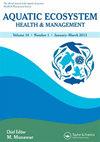改善五大湖补救行动计划的补救措施:政策德尔菲研究
IF 0.8
4区 环境科学与生态学
Q4 ENVIRONMENTAL SCIENCES
引用次数: 3
摘要
补救行动计划仍然是实施生态系统方法的主要方案,以恢复劳伦森五大湖被称为“关注地区”的退化地点。《平衡补救行动计划》于1985年开始实施,但进展缓慢,令人失望。在2012年《五大湖水质协议》修订后,《补救行动计划》继续实施,尽管对其优势和局限性进行了很少的系统检查。此外,2012年协议呼吁建立一个“近岸框架”,但没有明确理解根据这些补救行动计划制定的基于地方的治理方法的过程。在此背景下,我们进行了一项三轮匿名在线政策德尔菲研究,涉及来自五大湖流域政府、工业界、学术界和民间社会的数十名制定和实施补救行动计划的专家。第一轮收集了他们对补救行动计划的优势和局限性的直接了解。我们提炼了这些知识,并要求第二轮的研究参与者进一步反思,在他们作为补救行动计划实践者的经验中,哪些有效,哪些无效。我们发现,在第二轮中,人们对困扰项目的问题有不同的看法,但在第三轮中,人们对提出七个治理方案的愿望达成了意想不到的共识,这些方案由参与者进行了排名。排名还表明,人们一致认为,这些备选办法在一定程度上是可行的,而且很可能成功地加强目前对补救行动计划的管理。重要的是,结果与这些协作过程的结构和属性有关,因此我们强调需要关注强调补救行动计划过程的主要趋势和特征。这些发现将对在五大湖和其他地方开展的基于地方的近岸恢复战略具有广泛的意义。本文章由计算机程序翻译,如有差异,请以英文原文为准。
Remedies for improving Great Lakes Remedial Action Plans: A Policy Delphi study
Remedial Action Plans continue to be the principal program to operationalize an ecosystem approach to the restoration of degraded locations across the Laurentian Great Lakes called Areas of Concern. Initiated in 1985, the progress of Remedial Action Plans on balance has been slow and disappointing. The Remedial Action Plan program has been continued following revisions to the Great Lakes Water Quality Agreement in 2012 despite very little systematic inspection of its strengths and limitations. Further, the 2012 Agreement calls for a “nearshore framework” with no clarity on the process for understanding place-based governance methods as developed under these Remedial Action Plans. In this context, we conducted a three-round anonymous online Policy Delphi study involving several dozen experts in the development and implementation of Remedial Action Plans from across the Great Lakes basin within government, industry, academia and civil society. Round 1 collected their direct knowledge of the strengths and limitations of Remedial Action Plans. We distilled that knowledge and asked study participants in Round 2 to further reflect on what worked and what did not work in their experience as Remedial Action Plan practitioners. We found an expected diversity of opinion on what ails the program in Round 2, but an unexpected consensus on the desire to move forward with seven governance options that emerged and were ranked by participants in Round 3. Rankings also indicated a consensus that the options were somewhat feasible and likely to succeed as enhancements to the current governance of Remedial Action Plans. Importantly, the results relate to both the structure and attributes of these collaborative processes, and we therefore stress the need to focus on the predominant tendencies and characteristics that underline Remedial Action Plan processes. These findings will have broad significance for evolving place-based nearshore restoration strategies in the Great Lakes and elsewhere as such programs are initiated.
求助全文
通过发布文献求助,成功后即可免费获取论文全文。
去求助
来源期刊

Aquatic Ecosystem Health & Management
环境科学-海洋与淡水生物学
CiteScore
1.70
自引率
0.00%
发文量
1
审稿时长
18-36 weeks
期刊介绍:
The journal publishes articles on the following themes and topics:
• Original articles focusing on ecosystem-based sciences, ecosystem health and management of marine and aquatic ecosystems
• Reviews, invited perspectives and keynote contributions from conferences
• Special issues on important emerging topics, themes, and ecosystems (climate change, invasive species, HABs, risk assessment, models)
 求助内容:
求助内容: 应助结果提醒方式:
应助结果提醒方式:


